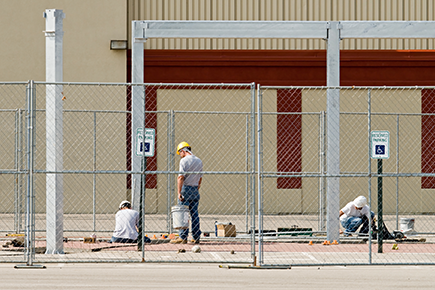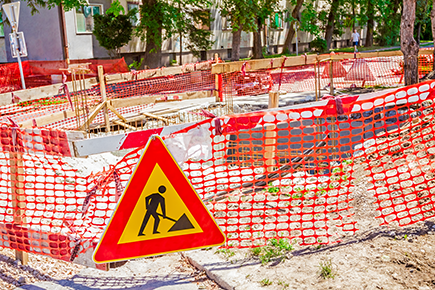A temporary fence, as the name suggests, is a type of fence that is designed to be easily installed, moved, and removed as needed. It is a versatile solution used in various situations where a temporary enclosure is required for a specific period of time. Temporary fences are commonly used in construction sites, outdoor events, public gatherings, crowd control, and other situations that call for temporary barriers.


Temporary fences provide a temporary solution for managing access, ensuring safety, and controlling the flow of people or vehicles in a specific area. Their versatility, portability, and ease of installation make them an invaluable tool in a wide range of applications where a temporary barrier is required.
Common places and scenarios where temporary fences are often utilized
- Construction Sites: Temporary fences are commonly used in construction sites to secure the perimeter and prevent unauthorized access. They help protect workers, equipment, and materials, as well as ensure safety for the general public by keeping them away from potential hazards.
- Outdoor Events: Temporary fences play a crucial role in managing crowd control and ensuring the safety and organization of outdoor events. They are used to define event boundaries, create designated entry and exit points, separate different areas within the event space, and guide the flow of attendees.
- Public Gatherings and Festivals: Temporary fences are employed in public gatherings such as parades, festivals, concerts, and sporting events. They help create designated areas for performances, seating, vendors, and pedestrian walkways. By controlling access and guiding the crowd, they contribute to the overall safety and smooth operation of the event.
- Temporary Parking Areas: In situations where temporary parking areas are needed, such as during large-scale events or construction projects, temporary fences are utilized to define parking boundaries, direct traffic flow, and ensure proper organization and management of vehicles.
- Security and Crowd Control: Temporary fences are often used for security purposes in various settings. They help control access to restricted areas, secure VIP sections, or create buffer zones around sensitive locations such as government buildings, airports, or construction sites.
- Road Work and Utilities: Temporary fences are utilized during road construction or repair projects to create barriers that keep workers and equipment safe and separate them from traffic. They help redirect pedestrians and vehicles away from construction zones, ensuring their safety and maintaining a smooth flow of traffic.
- Emergency Situations: Temporary fences can be deployed in emergency situations such as natural disasters, accidents, or crime scenes. They help establish perimeters and restrict access to ensure the safety and privacy of those involved in the emergency response efforts.
- Temporary Animal Enclosures: Temporary fences are used in situations where temporary animal enclosures are required, such as at outdoor events involving livestock, temporary pet adoption drives, or during animal rescue operations.
Some key features and uses of temporary fences
- Easy Installation and Portability: Temporary fences are designed for quick and easy installation. They typically consist of lightweight panels or sections that can be easily connected or secured together using clamps, hooks, or other fastening mechanisms. This allows for fast setup and takedown, making them highly portable and adaptable to changing needs.
- Flexibility and Customization: Temporary fences come in various sizes, heights, and configurations to accommodate different requirements. Panels can be easily connected or adjusted to create straight lines, corners, or enclosed areas of different shapes and sizes. This flexibility allows for customization based on the specific needs of the site or event.
- Security and Safety: Temporary fences provide a level of security and safety by creating a physical barrier and controlling access to a particular area. They can help prevent unauthorized entry, secure construction sites, protect equipment, and ensure crowd control and pedestrian safety during events or public gatherings.
- Visual Barrier: Temporary fences often serve as a visual barrier, separating different areas or activities. They can be used to designate restricted zones, construction zones, VIP areas, or to create privacy screens. By clearly defining boundaries, temporary fences help maintain order and organization in temporary settings.
- Temporary Signage: Temporary fences can be used as a platform for displaying signs or banners. This makes them useful for conveying important information, displaying event sponsors, promoting brands, or providing directions to attendees. Signage attached to temporary fences increases visibility and communication within the temporary environment.
- Rental and Cost-Effectiveness: Temporary fences are often available for rent from fencing companies, making them a cost-effective solution for short-term needs. Renting allows for flexibility and eliminates the need for long-term ownership or storage of the fence panels.
These are just a few examples of the many applications for temporary fences. Their versatility, portability, and ability to create quick and efficient enclosures make them an essential tool in managing temporary spaces, ensuring safety, and maintaining order in a wide range of situations.
Let Howell Fencing quote your
Residential, Commercial or Industrial
Fence or Wooden Deck Build or Repair
Daphne, Fairhope, Mobile, Saraland, Spanish Fort, Theodore, Tillman’s Corner
and surrounding areas